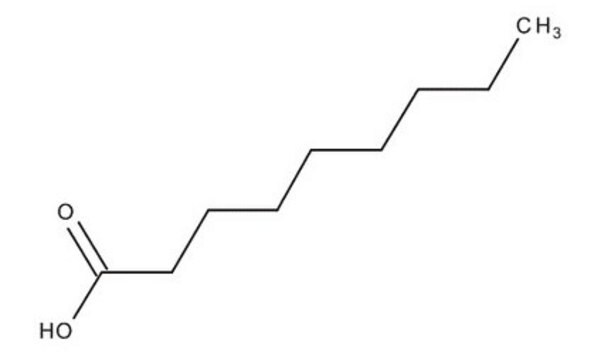N29902
Nonanoic acid
96%
Synonyme(s) :
Acid C9, Pelargonic acid
About This Item
Produits recommandés
Densité de vapeur
5.5 (vs air)
Niveau de qualité
Pression de vapeur
<0.1 mmHg ( 20 °C)
Essai
96%
Forme
liquid
Limite d'explosivité
9 %
Indice de réfraction
n20/D 1.432 (lit.)
pb
268-269 °C (lit.)
Pf
9 °C (lit.)
Densité
0.906 g/mL at 25 °C (lit.)
Chaîne SMILES
CCCCCCCCC(O)=O
InChI
1S/C9H18O2/c1-2-3-4-5-6-7-8-9(10)11/h2-8H2,1H3,(H,10,11)
Clé InChI
FBUKVWPVBMHYJY-UHFFFAOYSA-N
Vous recherchez des produits similaires ? Visite Guide de comparaison des produits
Mention d'avertissement
Warning
Mentions de danger
Conseils de prudence
Classification des risques
Eye Irrit. 2 - Skin Irrit. 2
Code de la classe de stockage
10 - Combustible liquids
Classe de danger pour l'eau (WGK)
WGK 1
Point d'éclair (°F)
278.6 °F - Pensky-Martens closed cup
Point d'éclair (°C)
137 °C - Pensky-Martens closed cup
Équipement de protection individuelle
Faceshields, Gloves, Goggles, type ABEK (EN14387) respirator filter
Faites votre choix parmi les versions les plus récentes :
Déjà en possession de ce produit ?
Retrouvez la documentation relative aux produits que vous avez récemment achetés dans la Bibliothèque de documents.
Les clients ont également consulté
Protocoles
In this study, SPME was used for the analysis of free fatty acids in Parmesan cheese using a 65 μm Carbowax/divinylbenzene (DVB) SPME fiber. Headspace extraction of the cheese sample was conducted at 65 °C for 15 minutes and analyzed by GC with FID detection. SPME is ideal for analyzing the volatiles associated with solid food samples. The phase chemistry of the Nukol GC column provides excellent peak shape of acidic compounds.
Notre équipe de scientifiques dispose d'une expérience dans tous les secteurs de la recherche, notamment en sciences de la vie, science des matériaux, synthèse chimique, chromatographie, analyse et dans de nombreux autres domaines..
Contacter notre Service technique






